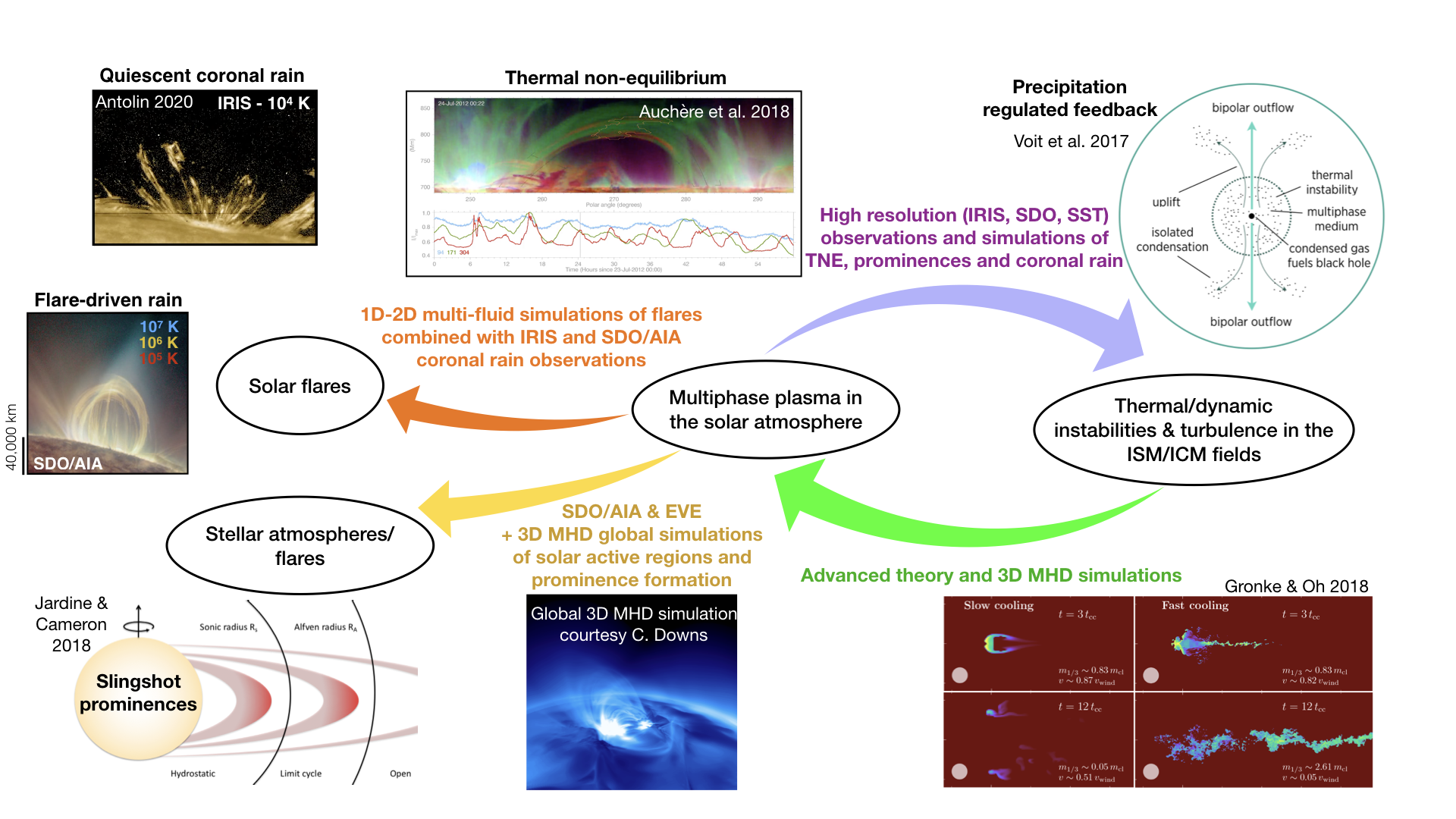Summary of the Scientific Objectives and Results
This Team brought together experts in the fields of solar and stellar physics, interstellar (ISM), circumgalactic (CGM) and intracluster (ICM) media around the topic of multiphase plasma (MP) and its role in the mass and energy cycles at multiple scales. The team met two times to discuss the following key questions:
-
Does MP occur similarly in other stars as on the Sun and can it influence solar/stellar winds and stellar evolution?
-
Is the creation of MP in solar/stellar atmospheres and in the ISM/CGM/ICM governed by the same physics?
-
How much of the solar corona is prone to thermal non-equilibrium and thermal instability? How does the MP quantity vary according to solar activity?
The Team achieved the first simulation of MP in a stellar atmosphere and demonstration of direct feeding into the stellar wind for centrifugal atmospheres. This constitutes a proof-of-concept that MP can significantly contribute to the angular momentum loss, potentially explaining the observed stellar spin-down (Q1) (Daley-Yates et al. 2023, Daley-Yates & Jardine 2024). We detected long-period intensity pulsations at open-closed boundaries on the Sun, also corroborated by numerical simulations, indicating a potentially important effect of MP on the solar wind (Q1). The dynamics of MP accretion, and particularly the effect of pressure drag was suggested as the main cause behind the observed deceleration of solar MP and empirical relation between terminal speed and mass (Q2). We measured the mass and energy of flare-driven solar MP and showed it to be similar to that of the hot coronal components (Şahin et al. 2023, Ruan et al. 2024, Şahin & Antolin 2024). We found that the rebound shocks from the rain’s impact can thermalise the coronal structures suggesting a similar feedback relation to that seen between the MP amount and AGN jet energy in the ICM (Antolin et al. 2023) (Q2). Furthermore, the topic of turbulence in low-beta (solar corona) and high beta (ISM/ICM) was discussed as a potential source of morphological and dynamical differences. We developed methods (RFit/Deep filter) that disambiguate the cool and hot emission in instrumental passbands, unlocking the possibility of quantifying MP over the solar corona and over a solar cycle (Antolin et al. 2024) (Q3).
Scientific Rationale
In this team we combine the appropriate expertise to tackle multi-disciplinary problems. With the help of the advanced theoretical knowledge achieved in the ISM and ICM fields, we will use the models from the extragalactic community and test them on the high resolution solar observations to investigate the role of multiphase plasma in the establishment of the solar atmospheric mass and energy cycle. In turn, the understanding achieved will be applied to the larger unresolved scales.
Cool plasmas (mostly at ≈ 104 K) embedded in a larger, much hotter (generally ≥ 106 K) medium are ubiquitous in different astrophysical systems such as solar & stellar coronae, the circumgalactic (CGM), interstellar (ISM) and intra-cluster (ICM) media. The role of these multiphase plasmas has been highlighted in mass and energy cycles at all such scales, from thermal non-equilibrium (TNE) cycles in the solar atmosphere to precipitation-regulated feedback cycles that drive star and galaxy formation. The properties of the cool plasmas across these multiple scales is strikingly similar, intimately linked to the yet unclear but fundamental mechanisms of coronal and ICM heating and instabilities of thermal or other nature.
Being so close and governed by small timescales, the solar corona constitutes a formidable astrophysics laboratory where we can spatially and temporally resolve the physics of producing and removing such multiphase plasma.
Recent ISSI team efforts have shown the multi-faceted response of the solar atmosphere to the heating, best exemplified by TNE cycles that manifest through puzzlingly week-long EUV intensity pulsations despite the stochastic nature of the solar atmosphere, and are now recognised as a major solar conundrum which we aim at solving. At small (≈ 100 km) scales, the solar atmospheric response comes through the generation of cool coronal rain, the seed of prominences, whose mysterious properties are similar to that of multiphase filamentary structure in the ISM and ICM or to molecular loops in the Galactic centre. Coronal rain also occurs across a wide energetic scale extending to flares. However, flare-driven rain, whose features seem recurrent in active stars, is often ignored and is not understood despite its significant energy budget. In all cases, a finely-tuned response to the heating is observed in the form of cooling, which we aim at quantifying. The formation and destruction of coronal rain and prominences has recently received further attention in stellar evolution, due to their potentially significant contribution and diagnostic capabilities to the otherwise unknown wind mass-loss rate. While the quantity and morphology of the cool plasma in the solar atmosphere is now known to be closely linked to the properties of coronal heating, the theoretical investigation of multiphase gas is far ahead in the ISM/ICM.
These results therefore provide a new perspective and strong new constraints on the mass and energy transfer in the solar corona that we will exploit. Furthermore, they provide unique cross-disciplinary opportunities for knowledge transfer offered by the multi-scale and multi-energetic manifestation of cool plasma across the universe.


